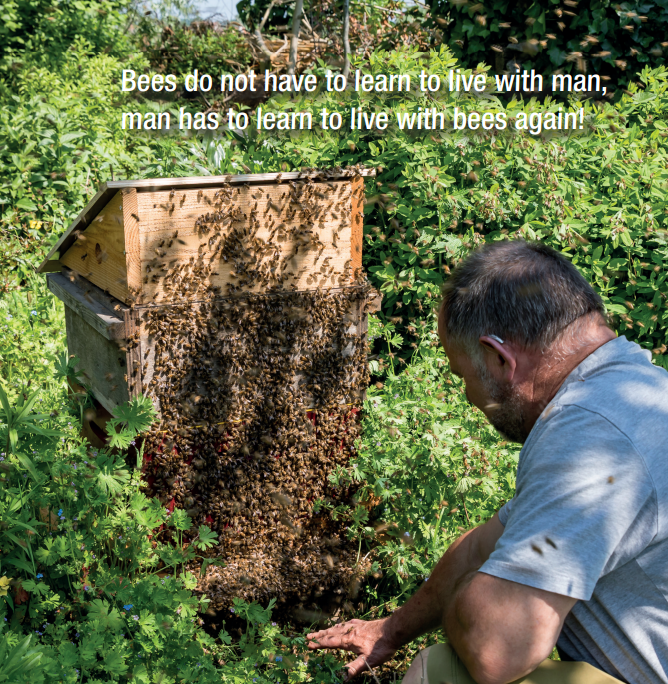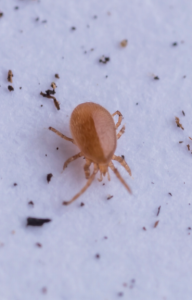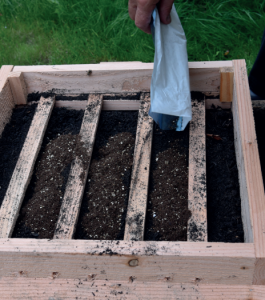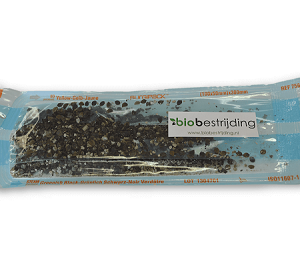[vc_row][vc_column][vc_column_text]
The Stratiolaelaps scimitus is a predatory mite living in the soil also known as Hypoaspis miles. This predatory mite focuses on a wide range of insects and is often used in horticulture to fight springtails and the pupal stage of thrips. The predatory mite has been used as a biological control against varroa mites for several years. Scientific research in Canada has shown that the direct scattering of predatory mites on the top bars or frames greatly reduces the varroa mite population. They have no negative influence on the bees, honey or wax in the hive. They can be used throughout the season, though an ambient temperature of 15°C is ideal. The predatory mites feed on the existing varroa mites in the hive. If they don’t have a bottom in the hive to hide in, the predatory mites starve and new predatory mites have to be brought in to fight varroa. The unique thing about Geert’s method, however, is that he creates a natural habitat for the predatory mites inside the hive, which means that he only must put S. scimitus into the soil once.


Close up predatory mite
The predatory mites actively search for varroa mites and stab them with their snouts. They mainly aim at the joints of the legs, ripping them apart and thus releasing haemolymph on which they feed. When the varroa mites are stung and fall, predatory mites crawl directly on top. They suck the body juices from the varroa mite (see punctured varroa mites on the image below), after which they start looking for the next prey. The predatory mites can be found everywhere in the hive, but they only attack the varroa mites if not attached to bees and not in the closed brood cells. However, Geert’s experience shows that the bees sometimes actively look for the predatory mites by sitting on the bottom. According to him, this might result in an even more thorough cleaning from varroa mites. The bees seem to know that they are not troubled by the varroa mites near the predatory mites. As soon as varroa mites can no longer be found in the hive, the predatory mites withdraw into the earth and survive on other organisms. S. scimitus is often sold in packs of 5,000 or 10,000 mites in a mixture of vermiculite and peat fed with flour mites. We recommend to use 5,000 predatory mite for each bee hive/ colony. You will have to inspect if the predatory mites are still active after a few weeks. A weekly inspection of the predatory mites could be advised. To do this, take some soil from under the hive and sprinkle it on a white sheet of paper, examine the sample with a loupe or magnifying glass to see if there are still living predatory mites. If you see one predatory mite crawling, there will certainly still be thousands in the soil. It is possible that the predatory mites die because there is not enough food or because the weather conditions were not ideal. In that case, put new predatory mites into the compost under the hive.
According to Geert, beekeeping must be kept simple and it is important to follow the nature of the bees. Too much human intervention and complicated working methods make it more difficult for the bees. Bees are extremely sensitive to stress factors and these are often strongly present in traditional beekeeping. To name just a few: the use of a varroa grid, queen excluders, smoke, replacing the honey stores with sugar for winter, opening and checking the hive too often, etc. Geert is convinced that being able to think like a bee and feel what they may or may not like is very important and a required quality of a beekeeper.

Releasing predatory mites in the hive
Using Warré hives you get as close to the natural habitat of the bees as possible. Using medicines or different acids to fight the varroa mite is something Geert can’t understand knowing that it is also possible to use a natural enemy of the varroa mite instead. On the internet, Geert bumped into a video made by British researchers who filmed a bee population living in the wild. To his big surprise, Geert saw predatory mites running on the comb. Something that the makers of the film had not noticed. This was the best proof for Geert that these predatory mites also have a function within a hive in the wild.
While many beekeepers try to prevent the swarming of their colonies, Geert loves it when his number of colonies multiply in this natural way. When it comes to the honey harvest, Geert first examines how much honey his hives need to survive themselves. He will only harvest the honey if they have too much. Processing the honey happens with full dedication using the home-made honey press. Whatever Geert does to his bees, his first thoughts always go to what is best for them. To Geert beekeeping is no longer a leisure activity, it has become a way of life.
Because bees are suffering in this world, Geert wants to pass on his knowledge to future generations. You can download the full publication through this link. Please also have a look at Geert’s personal website (www.delachendebijenkast.be) and get to know about Geert’s beekeeping method. Geert is also one of the core-members of the Belgian Natural Beekeeping Collective (www.natuurlijkimkeren.org).
[/vc_column_text][/vc_column][/vc_row][vc_row][vc_column width=”2/3″][vc_column_text]
[/vc_column_text][/vc_column][vc_column width=”1/3″]
-

Predatory mites against Varroa mite
€9,90 – €37,50 Incl. BTW Opties selecteren Dit product heeft meerdere variaties. Deze optie kan gekozen worden op de productpagina

